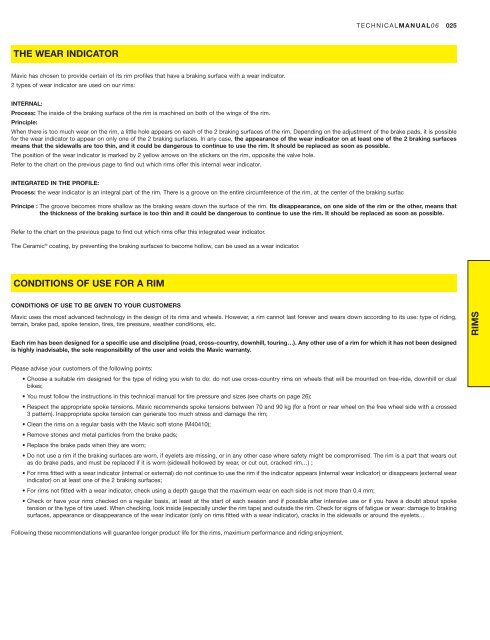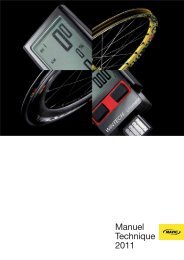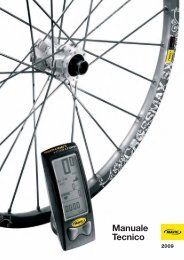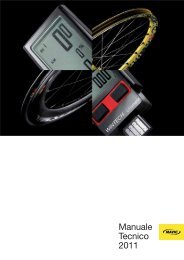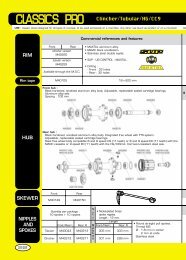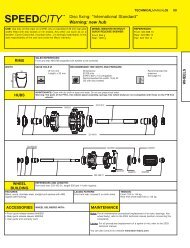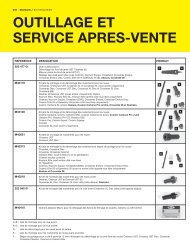Create successful ePaper yourself
Turn your PDF publications into a flip-book with our unique Google optimized e-Paper software.
THE WEAR INDICATOR<br />
Mavic has chosen to provide certain of its rim profiles that have a braking surface with a wear indicator.<br />
2 types of wear indicator are used on our rims:<br />
INTERNAL:<br />
Process: The inside of the braking surface of the rim is machined on both of the wings of the rim.<br />
Principle:<br />
When there is too much wear on the rim, a little hole appears on each of the 2 braking surfaces of the rim. Depending on the adjustment of the brake pads, it is possible<br />
for the wear indicator to appear on only one of the 2 braking surfaces. In any case, the appearance of the wear indicator on at least one of the 2 braking surfaces<br />
means that the sidewalls are too thin, and it could be dangerous to continue to use the rim. It should be replaced as soon as possible.<br />
The position of the wear indicator is marked by 2 yellow arrows on the stickers on the rim, opposite the valve hole.<br />
Refer to the chart on the previous page to find out which rims offer this internal wear indicator.<br />
INTEGRATED IN THE PROFILE:<br />
Process: the wear indicator is an integral part of the rim. There is a groove on the entire circumference of the rim, at the center of the braking surfac<br />
Principe : The groove becomes more shallow as the braking wears down the surface of the rim. Its disappearance, on one side of the rim or the other, means that<br />
the thickness of the braking surface is too thin and it could be dangerous to continue to use the rim. It should be replaced as soon as possible.<br />
Refer to the chart on the previous page to find out which rims offer this integrated wear indicator.<br />
The Ceramic ® coating, by preventing the braking surfaces to become hollow, can be used as a wear indicator.<br />
CONDITIONS OF USE FOR A RIM<br />
CONDITIONS OF USE TO BE GIVEN TO YOUR CUSTOMERS<br />
Mavic uses the most advanced <strong>tech</strong>nology in the design of its rims and wheels. However, a rim cannot last forever and wears down according to its use: type of riding,<br />
terrain, brake pad, spoke tension, tires, tire pressure, weather conditions, etc.<br />
Each rim has been designed for a specific use and discipline (road, cross-country, downhill, touring…). Any other use of a rim for which it has not been designed<br />
is highly inadvisable, the sole responsibility of the user and voids the Mavic warranty.<br />
Please advise your customers of the following points:<br />
Choose a suitable rim designed for the type of riding you wish to do: do not use cross-country rims on wheels that will be mounted on free-ride, downhill or dual<br />
bikes;<br />
You must follow the instructions in this <strong>tech</strong>nical manual for tire pressure and sizes (see charts on page 26);<br />
Respect the appropriate spoke tensions. Mavic recommends spoke tensions between 70 and 90 kg (for a front or rear wheel on the free wheel side with a crossed<br />
3 pattern). Inappropriate spoke tension can generate too much stress and damage the rim;<br />
Clean the rims on a regular basis with the Mavic soft stone (M40410);<br />
Remove stones and metal particles from the brake pads;<br />
Replace the brake pads when they are worn;<br />
Do not use a rim if the braking surfaces are worn, if eyelets are missing, or in any other case where safety might be compromised. The rim is a part that wears out<br />
as do brake pads, and must be replaced if it is worn (sidewall hollowed by wear, or cut out, cracked rim…) ;<br />
For rims fitted with a wear indicator (internal or external) do not continue to use the rim if the indicator appears (internal wear indicator) or disappears (external wear<br />
indicator) on at least one of the 2 braking surfaces;<br />
For rims not fitted with a wear indicator, check using a depth gauge that the maximum wear on each side is not more than 0.4 mm;<br />
Check or have your rims checked on a regular basis, at least at the start of each season and if possible after intensive use or if you have a doubt about spoke<br />
tension or the type of tire used. When checking, look inside (especially under the rim tape) and outside the rim. Check for signs of fatigue or wear: damage to braking<br />
surfaces, appearance or disappearance of the wear indicator (only on rims fitted with a wear indicator), cracks in the sidewalls or around the eyelets…<br />
Following these recommendations will guarantee longer product life for the rims, maximum performance and riding enjoyment.<br />
TECHNICALMANUAL06<br />
025<br />
RIMS


